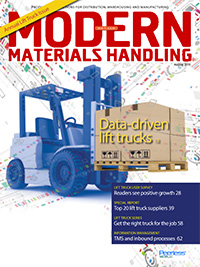Lift Truck Tips: Operator training drives more than safety
Whether a company accounts for every penny or hopes for the best, the value of an ongoing training program extends throughout an organization.
Latest Material Handling News
Overlooked no more: The importance of lift truck inspections Lithium transition: It’s all about the outcomes Safety for automatic guided vehicle (AGV) environments Assessing the move to lithium Leasing’s fleet management upside More Lift Truck TipsOnce you get your driver’s license, you are free to zip around the country on any road, in just about any vehicle you like. The only ongoing training involves concepts like the art of drinking coffee behind the wheel and some soul searching to avoid the perils of road rage. Forklift operators—whose jobs resemble a mix of the reliability of a commercial truck driver and the performance of a racecar driver—have a somewhat more rigorous training schedule. Hopefully.
“Students and trainees will say what they have to and do what you tell them to get through the initial training program. Where it falls down is after the fact,” says Rob Vetter, general manager of Ives Training. “Supervisors are often unaware of what is required to maintain proper operator habits and are therefore partially accountable for any incidents that might occur if those habits backslide— which they will if allowed to.”
Supervisors and mid-management are often left out of the training process, Vetter says. This is especially worrisome given their oversight plays such a crucial role in day-to-day safety. They don’t need to sit through the entire training program, but they must be exposed to some of the fundamental theories so they can spot right and wrong behaviors.
Unfortunately, bad habits can also be found at the management levels, where they tend to wait for incidents or other spikes in costs before pursuing a more disciplined or comprehensive training program. Vetter has experience as a forklift operator as well as a purchaser overseeing lift truck maintenance spends. When he noticed steep bills for items like sheared wheel lugs and bent rods, it was clearly a result of abuse and avoidable damage. Similarly, the company’s estimated 3% product damage during handling was closer to 30%.
“Certainly with larger companies that have identified training as a factor in increasing ROI, they are looking at lessening damage to product, equipment, personnel, insurance costs, etc.,” Vetter says. “The value proposition is there, but they sometimes do the right thing for the wrong (financial) reasons.” On the other hand, smaller companies that have not crunched the numbers tend to scoff at more involved training solutions, Vetter says. They do the minimum required, maybe buy an online course and hope any deviations from OSHA standards go unnoticed as regulators focus on the big players.
Vetter strongly recommends companies of all sizes familiarize themselves with OSHA’s powered industrial truck regulations, since ignorance is no excuse. In addition to endangering employees, disregarding the details can sap a company’s performance in other ways.

Article Topics
Lift Truck Tips News & Resources
Overlooked no more: The importance of lift truck inspections Lithium transition: It’s all about the outcomes Safety for automatic guided vehicle (AGV) environments Assessing the move to lithium Leasing’s fleet management upside Managing for lift truck operator safety Narrow aisle success: Think systems, then trucks More Lift Truck TipsLatest in Materials Handling
NetLogistik partners with Vuzix subsidiary Moviynt to offer mobility solutions for warehouses Materials Handling Robotics: The new world of heterogeneous robotic integration Lucas Watson appointed CSO for Körber’s Parcel Logistics business in North America Hyster recognizes Dealers of Distinction for 2023 Carolina Handling names Joe Perkins as COO C-suite Interview with Keith Moore, CEO, AutoScheduler.AI: MODEX was a meeting place for innovation Walmart deploying autonomous lift trucks at four of its high-tech DCs More Materials HandlingAbout the Author
Subscribe to Materials Handling Magazine

Find out what the world's most innovative companies are doing to improve productivity in their plants and distribution centers.
Start your FREE subscription today.
April 2024 Modern Materials Handling

Latest Resources











